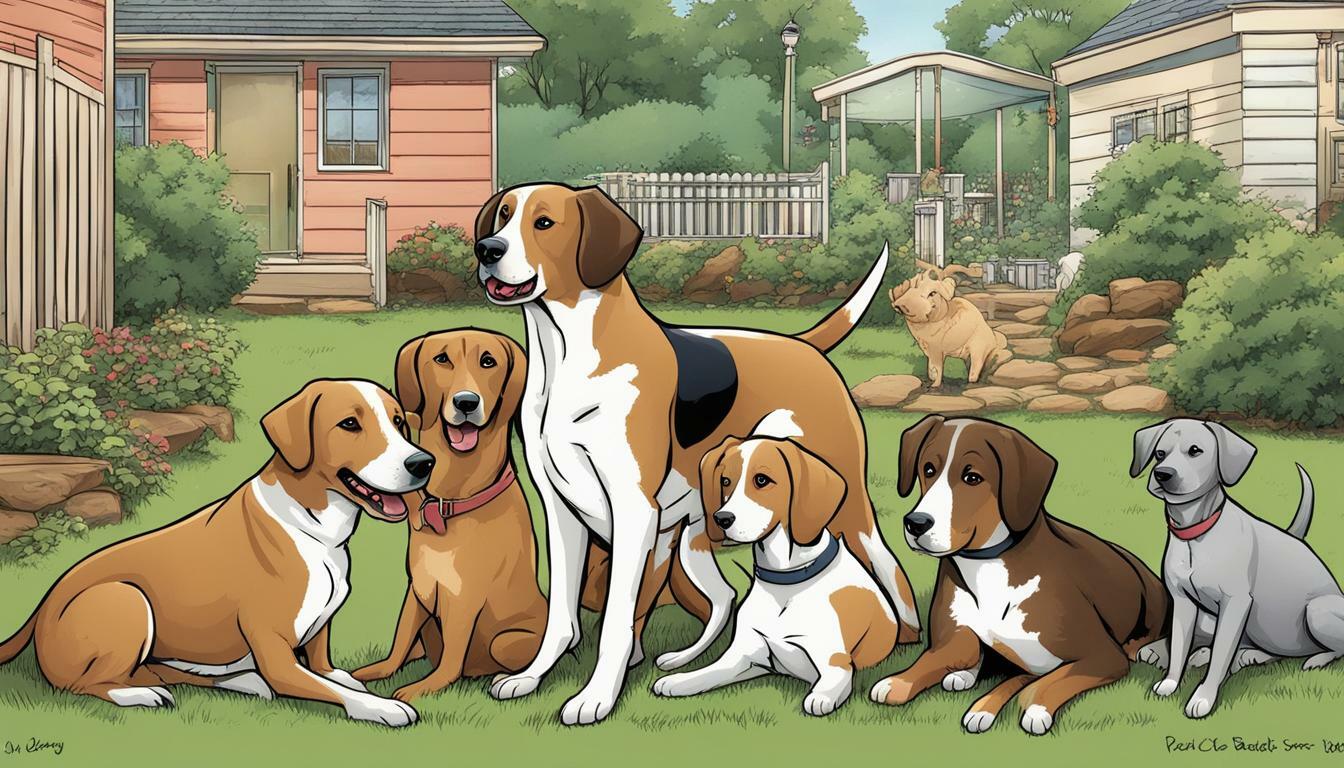The 5 Most Common Dog Behavior Problems

As a professional journalist, I’ve spent countless hours researching common dog behavior problems and their underlying causes. Every pet-owner dreads behavior issues in their beloved dogs, from aggression to separation anxiety. These problems can adversely affect a dog’s well-being and hamper the relationship with its owner. It is essential to address these issues early on and use effective techniques to correct the behavior and prevent further occurrences.
Key Takeaways:
- Dog behavior problems are common and can stem from various underlying causes.
- Early intervention can prevent these problems from escalating further.
- Effective training techniques, consistency, and a safe environment can help overcome behavior problems.
Understanding Dog Aggression
Dog aggression is one of the most common behavior problems that pet owners face. It can manifest in many different forms, including territorial aggression, fear-based aggression, and resource guarding. As an experienced dog behaviorist, I understand the complexity of dog aggression and the importance of identifying its underlying causes.
Types of Dog Aggression
Territorial aggression: This type of aggression occurs when a dog feels threatened and tries to defend its territory from perceived intruders.
Fear-based aggression: Fear-based aggression happens when a dog feels scared or threatened and tries to protect itself by becoming aggressive. This is often seen in dogs that have been poorly socialized or have had traumatic experiences.
Resource guarding: Resource guarding is when a dog becomes aggressive when it feels its possessions, such as food or toys, are being threatened.
The Causes of Dog Aggression
There are numerous causes of dog aggression. Some common ones include:
- Poor socialization
- Fear and anxiety
- Territorial instincts
- Pain or illness
- Previous traumatic experiences
It is crucial to identify the underlying cause of a dog’s aggressive behavior to develop an effective management and treatment plan.
Managing Dog Aggression
Managing dog aggression requires a detailed assessment of the dog’s behavior, as well as a comprehensive training plan. Effective training techniques, including desensitization and counterconditioning, can help reduce a dog’s aggression towards people or other animals. It is essential to work with a professional dog trainer or a certified behaviorist for the best results. Additionally, dog owners can minimize the risk of aggressive incidents by implementing appropriate management strategies, such as proper socialization, leash and muzzle training, and environmental enrichment.
Addressing Leash Pulling
Leash pulling can be a frustrating problem for dog owners, making walks uncomfortable and potentially dangerous. Understanding why dogs pull on the leash is an essential step in addressing this behavior issue.
Typically, dogs pull on the leash because they are excited or anxious to explore their surroundings, or they simply want to move faster than their owner. Whatever the reason, it’s important to know how to train your dog to walk politely on a leash.
One of the most effective techniques for teaching dogs to walk calmly on a leash is to use positive reinforcement. This involves giving your dog rewards, such as treats or praise, when they exhibit the desired behavior.
To start the training process, begin walking with your dog on a loose leash. When your dog walks calmly by your side, reward them with a treat or verbal praise. If they start to pull, stop walking and wait for your dog to turn towards you. Once they do, reward them with a treat and continue walking.
Another helpful technique is to change direction when your dog pulls on the leash. This will teach the dog that pulling will not get them where they want to go.
Consistency is key when it comes to training your dog to walk politely on a leash. Practice daily and gradually increase the duration of your walks. Remember to use positive reinforcement and be patient with your dog as they learn this new behavior.
Overcoming Separation Anxiety in Dogs
Separation anxiety is a common behavior problem among dogs, which can cause distress for both dogs and owners. The signs of separation anxiety vary, but some of the most common symptoms include excessive barking, destructive behavior, and pacing. In severe cases, some dogs may even injure themselves or attempt to escape.
Separation anxiety can have multiple causes, including past trauma, lack of socialization, or a change in routine. Addressing the underlying reason for the behavior is key to finding effective solutions.
One of the most effective strategies for overcoming separation anxiety is to gradually acclimate the dog to being alone. The goal is to teach the dog that being alone is okay and not a cause for panic. This can be achieved through a process called desensitization, where the dog is exposed to short periods of alone time, gradually increasing the duration over time.
Another effective solution is to provide the dog with a safe space or den where they feel comfortable and secure, such as a crate or designated area in the house. This can help alleviate anxiety and provide a sense of security when the owner is away.
Positive reinforcement techniques can also be highly effective in treating separation anxiety. Rewarding the dog for calm behavior when alone can reinforce positive behavior and help alleviate anxiety.
Finally, seeking the guidance of a professional dog trainer or behaviorist can be helpful in addressing severe cases of separation anxiety. A qualified professional can provide a personalized plan tailored to the dog’s specific needs and behavior.
Tackling Barking Problems in Dogs
Barking is a natural behavior for dogs, but excessive barking can become a nuisance and disrupt the peace in your home. It’s important to understand the different types of barking to effectively address the problem. Boredom barking, fear barking, and territorial barking are some of the most common types of barking you may encounter in your pet.
Boredom barking is often a result of insufficient physical and mental stimulation. Dogs that are left alone for extended periods or confined to small spaces without any toys or activities are prone to boredom barking. To address this, provide your dog with interactive toys, puzzle games, and ample exercise opportunities.
Fear barking is a response to perceived threats or dangers, such as loud noises or unfamiliar people or animals. To help your dog overcome fear barking, gradually expose them to new situations and stimuli in a controlled and positive manner. This can help them build confidence and reduce their anxiety levels.
Territorial barking is a protective behavior in response to perceived threats to your pet’s territory. This can include barking at the mailman, delivery drivers, or even visitors to your home. To manage territorial barking, establish clear boundaries and rules for your dog. Reward them for quiet behavior and use positive reinforcement training to teach them to remain calm in the presence of perceived threats.
Overall, addressing barking problems requires patience and persistence. Avoid using punishment, as this can worsen the behavior and damage your relationship with your pet. Instead, focus on positive reinforcement techniques and provide a stimulating environment to keep your dog mentally and physically fulfilled.
Managing Fear and Phobias in Dogs
Fear and phobias are common in dogs, and they can lead to significant behavior problems. Some dogs may become terrified of loud noises like thunderstorms and fireworks, while others may become anxious when left alone. Regardless of the source of fear, it’s crucial to manage these issues for your dog’s well-being and happiness.
One critical approach to managing fear and phobias in dogs is desensitization. This technique involves gradually introducing your dog to the source of fear in a controlled and safe environment. For example, if your dog is scared of loud noises, desensitization involves exposing your dog to the noise at a low volume and gradually increasing the sound over time. This approach can help your dog become more comfortable and confident in facing their fears.
Counterconditioning is another technique that can be used to manage fear and phobias. The goal of this technique is to change your dog’s emotional response to the source of fear. This can be done by pairing the source of fear with something positive, such as treats or affection. Over time, your dog can learn to associate the source of fear with positive experiences, which can help reduce their anxiety.
Thunderstorm Phobia
Thunderstorm phobia is a common fear in dogs, and it can cause severe anxiety and stress. Some dogs may pant excessively, pace, whine, or even hide during a thunderstorm. If your dog suffers from thunderstorm phobia, there are several things you can do to help manage their anxiety.
One practical step is to create a safe, comfortable space for your dog. This can be a crate or a room where your dog feels safe and secure during a thunderstorm. You can also try to distract your dog with toys or treats and play calming music to help drown out the sound of the thunder.
Desensitization and counterconditioning can also be effective in managing thunderstorm phobia. By gradually exposing your dog to the sound of thunder and pairing it with positive experiences, you can help your dog become more comfortable and confident during a thunderstorm.
Fear of Strangers
If your dog is fearful of strangers, it’s important to address the issue to prevent aggression and potential harm to others. One approach is to gradually introduce your dog to new people in a controlled environment. This can be done by having strangers offer treats or toys to your dog, allowing your dog to approach and sniff them on their terms.
Counterconditioning can also be effective in managing fear of strangers. By pairing the presence of strangers with positive experiences like treats and praise, your dog can learn to associate strangers with positive experiences and become less fearful over time.
It’s crucial to remember that managing fear and phobias takes time, patience, and persistence. By using these techniques and staying committed to training, you can help your dog become more confident and comfortable in facing their fears.
Puppy Behavior Issues
As cute and cuddly as puppies may be, they can exhibit some challenging behavior issues. It is essential to address these issues early on to prevent them from becoming ingrained habits that are difficult to change. Here are some common puppy behavior problems and techniques for managing them:
- Biting: Puppies have sharp teeth, and they love to play with them. However, they may not understand that their biting hurts. When your puppy nips at you, redirect its attention to an appropriate chew toy. If the puppy continues to bite, say “no” firmly and remove yourself from the situation for a few minutes.
- Chewing: Puppies love to explore with their mouths, and they may chew on anything from shoes to furniture. Provide your puppy with plenty of appropriate chew toys, and keep all forbidden items out of reach. Consistency is key in training your puppy what is acceptable to chew and what is not.
- House-training difficulties: Potty training can be a frustrating process, but with patience and consistency, your puppy will learn. Start by taking your puppy outside frequently and rewarding it with treats and praise when it eliminates outside. Be sure to supervise your puppy when indoors and watch for signs that it needs to go out, such as sniffing or circling.
Addressing these behavior problems early on will help your puppy grow into a well-behaved adult dog. Remember to use positive reinforcement techniques and be patient as your puppy learns.
Establishing a healthy bond with your dog is essential for their overall well-being and behavior. As a professional copywriting journalist, I understand that dog behavior problems are a common issue faced by pet owners, and building a strong relationship with your furry friend can help prevent or manage these problems.
Key Takeaways:
- Positive reinforcement and consistency are essential for building a healthy bond with your dog.
- Obedience training is a critical aspect of maintaining a well-behaved dog.
- Developing trust and communication with your dog is crucial for their overall well-being.
Creating a Safe Environment for Your Dog
Providing a safe and secure environment is essential for preventing and managing behavior problems in your dog. A structured and enriched environment can promote positive behavior and enhance your furry friend’s overall well-being.
| Considerations for a Safe Environment |
|---|
| Physical and Mental Stimulation: Dogs need regular exercise and mental stimulation to stay healthy and happy. Provide opportunities for playtime, walks, and interactive toys to keep your dog physically and mentally engaged. |
| Proper Containment: Ensure your dog’s living space is secure and safe. Use gates, crates, or barriers to prevent access to hazardous areas such as kitchens, garages, or pools. |
| Elimination of Potential Hazards: Dogs are curious creatures and can easily get into trouble. Ensure your home is free of potential hazards such as toxic plants, electrical wires, or small objects that can be ingested. |
By implementing these considerations, you can create a safe and secure environment for your dog and prevent potential behavior problems from arising.
Seeking Professional Help for Dog Behavior Problems
If you’re struggling to address your dog’s behavior problems, seeking the assistance of a professional trainer or behaviorist can make all the difference. These experts have the knowledge and experience to identify the root cause of your dog’s behavior issues and develop a customized plan to address them.
There are several benefits to working with a professional, including:
- Access to specialized training techniques and tools
- Individualized attention and guidance
- Increased likelihood of successful behavior modification
- Assurance of working with a qualified and experienced trainer or behaviorist
When searching for a professional to support you and your dog, consider factors such as qualifications, certifications, and experience. Look for trainers who use positive reinforcement techniques and have experience working with dogs similar to yours.
During the training process, you can expect to work closely with the trainer or behaviorist to develop a comprehensive training plan. This may include in-person training sessions, homework assignments, and ongoing support and guidance.
By seeking professional help and working collaboratively with a qualified trainer or behaviorist, you can effectively address your dog’s behavior problems and strengthen your bond with them.
Implementing Positive Reinforcement Techniques
When it comes to correcting and preventing behavior problems in dogs, positive reinforcement techniques can be incredibly effective. Positive reinforcement is the practice of rewarding desired behavior and ignoring or redirecting undesired behavior. This method relies on reinforcing good behavior with treats, toys, praise, or other rewards, promoting a positive and constructive learning experience for your dog.
It’s essential to establish clear expectations and communicate effectively with your dog during training sessions to promote positive reinforcement. Avoid using physical punishment or harsh language as these methods can damage the bond between you and your dog and cause anxiety and fear.
One technique to reinforce good behavior is to use a clicker. A clicker is a small handheld device that makes a distinct clicking sound when pressed. The sound serves as a marker to indicate that your dog has performed the desired behavior, followed by a reward such as a treat, toy, or praise.
Another technique is to use shaping, which involves breaking down a complex behavior into small, manageable steps. When your dog performs each step correctly, reward them with praise or a treat. Shaping helps to reinforce positive behavior incrementally, encouraging progress and confidence.
Remember, consistency is key when implementing positive reinforcement techniques. Reward your dog immediately after they perform the desired behavior, and be patient as they learn. Reinforcing good behavior consistently and positively can significantly impact your dog’s behavior and strengthen your relationship.
Maintaining Consistency and Routine
Consistency and routine are essential components of effective dog training and behavior modification.
When working with dogs to eliminate negative behaviors and reinforce positive ones, it’s crucial to establish a clear set of rules and expectations that remain consistent over time. This means using the same training techniques, commands, and rewards for each behavior and ensuring that every member of the household is on the same page.
Setting and maintaining a routine is also important. Dogs thrive on predictability and benefit from regular feeding, exercise, and training schedules. For example, if you want to train your dog to stop barking excessively, you’ll need to consistently redirect their attention and reward them for quiet behavior in a structured, predictable way.
Remember that behavior modification is a process that takes time, patience, and persistence. Consistency and routine help to establish trust and foster a positive relationship between you and your dog.
Consistency and routine go hand in hand with positive reinforcement. By rewarding desired behaviors and ignoring or redirecting negative ones, you’ll be able to create a clear and consistent message for your dog to follow.
Keep in mind that it’s important to be patient and persistent throughout the behavior modification process. Don’t expect immediate results, and be prepared to adjust your training techniques as needed. By maintaining consistency and routine, you’ll be well on your way to successfully modifying your dog’s behavior.
Patience and Persistence in Behavior Modification
As a professional dog trainer, I understand that behavior modification takes time and dedication. It can be frustrating when progress seems slow, but it’s important to remember that each dog learns at their own pace. Consistency and persistence are key in addressing and preventing behavior problems in dogs.
When implementing behavior modification techniques, it’s essential to maintain a positive mindset and stay determined throughout the training process. Dogs can sense our energy and emotions, and a negative attitude can hinder progress. Celebrate small victories and remain patient when setbacks occur.
It’s also important to note that some behavior problems may require more time and effort to correct. Aggressive behavior, for example, can take longer to address than leash pulling. Don’t give up, and don’t hesitate to seek professional help if needed.
Remember that behavior modification is a journey, not a destination. Consistency and dedication in training, along with patience and persistence, will ultimately lead to long-term success in managing behavior problems in dogs.
The Role of Exercise and Mental Stimulation
Regular exercise and mental stimulation are crucial components in preventing and managing behavior problems in dogs. Not only do they promote physical health and well-being, but they also help to keep dogs mentally fulfilled and engaged.
Physical exercise is important for keeping dogs fit and healthy. It is recommended that dogs engage in at least 30 minutes of moderate exercise each day, such as walking, playing, or running. The amount of exercise needed can vary depending on the breed, age, and health of the dog. It is important to consult with a veterinarian to determine an appropriate exercise regimen for your dog.
In addition to physical exercise, mental stimulation is equally important for dogs. Dogs are intelligent animals that need mental engagement to prevent boredom, anxiety, and destructive behavior. Mental stimulation can come in the form of interactive toys, puzzle games, and training exercises. These activities challenge dogs’ brains and provide a sense of accomplishment and fulfillment.
Interactive toys, such as treat-dispensing toys, can keep dogs entertained and engaged for hours. Puzzle games, such as hide-and-seek or obstacle courses, can challenge dogs’ problem-solving skills and provide a sense of accomplishment when they successfully complete the task. Training exercises, such as teaching new commands or tricks, can help keep dogs mentally stimulated while strengthening the bond with their owner.
It is important to remember that exercise and mental stimulation should be appropriate for your dog’s age, breed, and health. Consult with a veterinarian or professional trainer to determine the best activities for your dog. By incorporating regular exercise and mental stimulation into your dog’s routine, you can help prevent and manage behavior problems while promoting overall health and well-being.
Conclusion
As a dog behavior journalist, I have discussed the five most common behavior problems in dogs and provided insights into the potential causes, symptoms, and solutions for managing and overcoming these issues.
It is crucial to remember that behavior modification takes time, patience, and consistency. Positive reinforcement techniques, seeking professional help, and maintaining a structured and enriched environment are all effective strategies for addressing behavior problems in dogs.
By taking the time to understand and address behavior problems in dogs, pet owners can enhance their overall well-being and strengthen the bond with their loyal companions. Regular exercise and mental stimulation, such as interactive toys and puzzle games, play a crucial role in keeping dogs mentally and physically fulfilled.
Remember, maintaining a positive mindset and staying determined throughout the training process are essential for achieving lasting behavior changes in dogs. With dedication, patience, and the right approach, pet owners can effectively overcome behavior problems and enjoy a happy and healthy relationship with their furry friends.
FAQ
Q: What are the most common dog behavior problems?
A: The most common dog behavior problems include aggression, leash pulling, separation anxiety, barking problems, fear and phobias, and puppy behavior issues.
Q: How can I address dog aggression?
A: Understanding the types of aggression, such as territorial, fear-based, and resource guarding, is essential. Seeking professional help and implementing behavior modification techniques can help manage and overcome aggressive behavior in dogs.
Q: What can I do about leash pulling?
A: To address leash pulling, it is important to understand the reasons behind it. Consistent training techniques, such as positive reinforcement and redirecting attention, can help teach dogs to walk politely on a leash.
Q: How do I help my dog overcome separation anxiety?
A: Recognizing the signs of separation anxiety and providing a structured training plan can help dogs overcome separation anxiety. Techniques such as desensitization and counterconditioning can be effective in managing this behavior problem.
Q: How can I tackle barking problems in my dog?
A: Identifying the type of barking, such as boredom, fear, or territorial barking, is the first step. Implementing techniques like positive reinforcement, training exercises, and environmental management can help address and manage barking problems in dogs.
Q: How do I manage fear and phobias in my dog?
A: Understanding the specific fears and phobias your dog has and providing a safe and supportive environment is crucial. Techniques like desensitization, counterconditioning, and using calming aids can help dogs cope with and overcome their fears.
Q: What are common puppy behavior issues?
A: Common puppy behavior issues include biting, chewing, and house-training difficulties. Consistent training, proper socialization, and positive reinforcement can help manage and address these behaviors.
Q: How do I build a healthy bond with my dog?
A: Communication, trust, and positive reinforcement are key to building a healthy relationship with your dog. Obedience training and spending quality time together can contribute to a strong bond.
Q: How can I create a safe environment for my dog?
A: Providing a structured and enriched environment is essential for preventing and managing behavior problems. This includes mental and physical stimulation, proper containment, and removing potential hazards.
Q: When should I seek professional help for dog behavior problems?
A: If you are struggling to manage behavior problems on your own, it is advisable to seek professional help. A qualified trainer or behaviorist can provide guidance, develop a customized training plan, and support you throughout the process.
Q: How effective is positive reinforcement in correcting behavior problems?
A: Positive reinforcement is a powerful tool in shaping desirable behavior in dogs. Rewards-based training methods and consistent reinforcement can be highly effective in correcting and preventing behavior problems.
Q: Why is consistency and routine important in dog training?
A: Consistency and routine help dogs understand what is expected of them and reduce confusion. By maintaining a consistent training approach and setting clear expectations, you can effectively address and prevent behavior problems.
Q: What role does patience and persistence play in behavior modification?
A: Behavior modification takes time, patience, and persistence. Having a positive mindset, staying dedicated to the training process, and being consistent will contribute to successful behavior modification.
Q: How does exercise and mental stimulation affect behavior problems in dogs?
A: Regular exercise and mental stimulation are crucial for preventing and managing behavior problems. Physical activities and interactive toys or puzzle games keep dogs mentally and physically fulfilled, reducing the likelihood of behavior issues arising.







